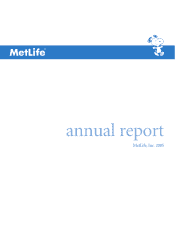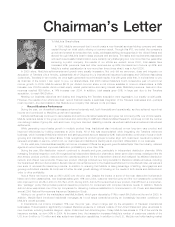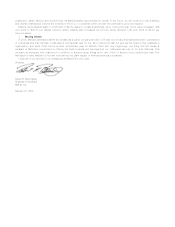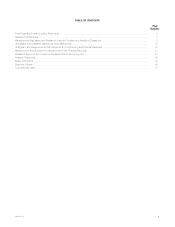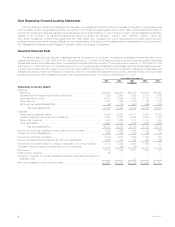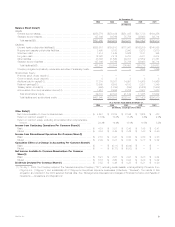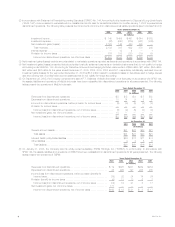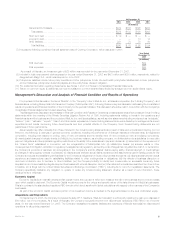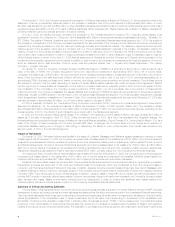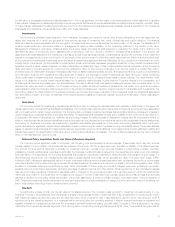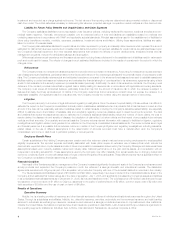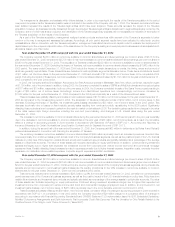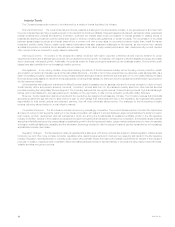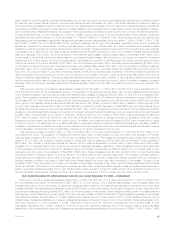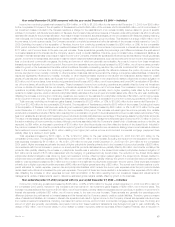MetLife 2005 Annual Report Download - page 11
Download and view the complete annual report
Please find page 11 of the 2005 MetLife annual report below. You can navigate through the pages in the report by either clicking on the pages listed below, or by using the keyword search tool below to find specific information within the annual report.impairment and recorded as a charge against net income. The fair values of the reporting units are determined using a market multiple or discounted
cash flow model. The critical estimates necessary in determining fair value are projected earnings, comparative market multiples and the discount rate.
Liability for Future Policy Benefits and Unpaid Claims and Claim Expenses
The Company establishes liabilities for amounts payable under insurance policies, including traditional life insurance, traditional annuities and non-
medical health insurance. Generally, amounts are payable over an extended period of time and liabilities are established based on methods and
underlying assumptions in accordance with GAAP and applicable actuarial standards. Principal assumptions used in the establishment of liabilities for
future policy benefits are mortality, morbidity, expenses, persistency, investment returns and inflation. Utilizing these assumptions, liabilities are estab-
lished on a block of business basis.
The Company also establishes liabilities for unpaid claims and claim expenses for property and casualty claim insurance which represent the amount
estimated for claims that have been reported but not settled and claims incurred but not reported. Liabilities for unpaid claims are estimated based upon
the Company’s historical experience and other actuarial assumptions that consider the effects of current developments, anticipated trends and risk
management programs, reduced for anticipated salvage and subrogation.
Differences between actual experience and the assumptions used in pricing these policies and in the establishment of liabilities result in variances in
profit and could result in losses. The effects of changes in such estimated liabilities are included in the results of operations in the period in which the
changes occur.
Reinsurance
The Company enters into reinsurance transactions as both a provider and a purchaser of reinsurance. Accounting for reinsurance requires extensive
use of assumptions and estimates, particularly related to the future performance of the underlying business and the potential impact of counterparty credit
risks. The Company periodically reviews actual and anticipated experience compared to the aforementioned assumptions used to establish assets and
liabilities relating to ceded and assumed reinsurance and evaluates the financial strength of counterparties to its reinsurance agreements using criteria
similar to that evaluated in the security impairment process discussed previously. Additionally, for each of its reinsurance contracts, the Company must
determine if the contract provides indemnification against loss or liability relating to insurance risk, in accordance with applicable accounting standards.
The Company must review all contractual features, particularly those that may limit the amount of insurance risk to which the reinsurer is subject or
features that delay the timely reimbursement of claims. If the Company determines that a reinsurance contract does not expose the reinsurer to a
reasonable possibility of a significant loss from insurance risk, the Company records the contract using the deposit method of accounting.
Litigation
The Company is a party to a number of legal actions and regulatory investigations. Given the inherent unpredictability of these matters, it is difficult to
estimate the impact on the Company’s consolidated financial position. Liabilities are established when it is probable that a loss has been incurred and the
amount of the loss can be reasonably estimated. Liabilities related to certain lawsuits, including the Company’s asbestos-related liability, are especially
difficult to estimate due to the limitation of available data and uncertainty regarding numerous variables used to determine amounts recorded. The data
and variables that impact the assumptions used to estimate the Company’s asbestos-related liability include the number of future claims, the cost to
resolve claims, the disease mix and severity of disease, the jurisdiction of claims filed, tort reform efforts and the impact of any possible future adverse
verdicts and their amounts. On a quarterly and annual basis the Company reviews relevant information with respect to liabilities for litigation, regulatory
investigations and litigation-related contingencies to be reflected in the Company’s consolidated financial statements. The review includes senior legal
and financial personnel. It is possible that an adverse outcome in certain of the Company’s litigation and regulatory investigations, including asbestos-
related cases, or the use of different assumptions in the determination of amounts recorded could have a material effect upon the Company’s
consolidated net income or cash flows in particular quarterly or annual periods.
Employee Benefit Plans
Certain subsidiaries of the Holding Company sponsor pension and other retirement plans in various forms covering employees who meet specified
eligibility requirements. The reported expense and liability associated with these plans require an extensive use of assumptions which include the
discount rate, expected return on plan assets and rate of future compensation increases as determined by the Company. Management determines these
assumptions based upon currently available market and industry data, historical performance of the plan and its assets, and consultation with an
independent consulting actuarial firm. These assumptions used by the Company may differ materially from actual results due to changing market and
economic conditions, higher or lower withdrawal rates or longer or shorter life spans of the participants. These differences may have a significant effect on
the Company’s consolidated financial statements and liquidity.
Financial Condition
As a result of the Travelers acquisition, management of the Company increased significantly the size and scale of the Company’s core insurance and
annuity products and expanded the Company’s presence in both the retirement & savings domestic and international markets. The distribution
agreements executed with Citigroup as part of the acquisition will provide the Company with one of the broadest distribution networks in the industry.
The Travelers assets and liabilities acquired of $102 billion and $90 billion, respectively, have been included in the consolidated balance sheet of the
Company at their estimated fair market values as of the date of acquisition, July 1, 2005, and significantly increased the Company’s assets and liabilities
in its consolidated financial statements as of December 31, 2005, as included elsewhere herein. The purchase price of $12 billion was financed through
the issuance of common stock of $1 billion to Citigroup, issuances to the public of preferred stock of $2 billion, common equity units of $2 billion and
debt securities of $3 billion and the use of cash on hand of $4 billion.
Results of Operations
Executive Summary
MetLife, Inc. is a leading provider of insurance and other financial services to millions of individual and institutional customers throughout the United
States. Through its subsidiaries and affiliates, MetLife, Inc. offers life insurance, annuities, automobile and homeowners insurance and retail banking
services to individuals, as well as group insurance, reinsurance and retirement & savings products and services to corporations and other institutions.
Outside the United States, the MetLife companies have direct insurance operations in Asia Pacific, Latin America and Europe. MetLife is organized into
five operating segments: Institutional, Individual, Auto & Home, International and Reinsurance, as well as Corporate & Other.
MetLife, Inc.
8

